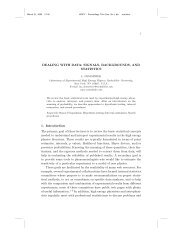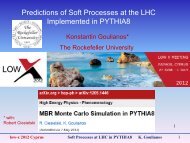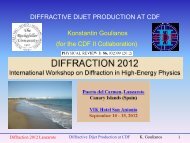blois-2003
blois-2003
blois-2003
You also want an ePaper? Increase the reach of your titles
YUMPU automatically turns print PDFs into web optimized ePapers that Google loves.
Soft and Hard Diffraction at CDFKonstantin GoulianosThe Rockefeller University & The CDF CollaborationXth Blois Workshop on Elastic and Diffractive Scattering23-28 June <strong>2003</strong>, Helsinki, Finland
IntroductionWhat is hadronic diffraction?PROTON-PROTON ELASTIC SCATTERINGdσdtPROTONBEAMpTARGETPROTONp'DIFFRACTIONPATTERN∆PLξ =P2d σ2coherencedt dMLDiffractiondissociationM=S2Xm≤mπpP 0R TR L∆ P T, ∆ P LmP p01~ξMXKG, Phys. Rep. 101 (1983) 1714-7 June <strong>2003</strong> K. Goulianos, Low-x Workshop, Nafplion 2
"rapidity gaps are regions of rapidity devoid of particlesFrom Poisson statistics:P(∆η)Diffraction and Rapidity Gaps! Non-diffractive interactions: ! Diffractive interactions:rapidity gaps are formed byrapidity gaps, like diamonds,multiplicity fluctuations‘live for ever’=e−ρ∆y⎛⎜ ρ =⎝dn ⎞⎟dy ⎠(r=particle density in rapidity space)∆y≈ − lnξ=pXxDIFFRACTIVECLUSTERIPln s − ln M0ηmaxpRAPIDITYGAP-ln ξp2protonln(2p/p )TdGaps are exponentially suppressedσ2dM1M~2d→σ ~ constantd∆y" large rapidity gaps are signatures for diffraction
# Quark/gluon exchange across a rapidity gap:# No particles radiated in the gap:POMERONthe exchange is COLOR-SINGLET with quantum numbers of vacuum# Rapidity gap formation:The PomeronNON-PERTURBATIVE# Diffraction probes the large distance aspects of QCD:?POMERON CONFINEMENT! PARTONIC STRUCTURE! FACTORIZATION
! Elastic scattering! Total cross section! DiffractionSOFT diffractionDiffraction at CDF in Run I0000 1111p 010000 11110000 11110000 11110000 11110000 1111 010000 1111 010000 1111 01p0000 11110000 1111 010000 11110000 1111φControlsamplePRD 50 (1994) 5518ηNon−Diffractive(ND)PRD 50 (1994) 5550ppφIPηSingle−Diffractive(SD)φppIPηDouble Diffractive(DD)ppφIPIPηDouble PomeronExchange (DPE)ppφIPIPηSingle + DoubleDiffractive (SDD)PRD PRL PRL PRL50 (1994) 5535 87 (2001)141802 to be sub’d acceptedHARD diffractionPRL referencewith roman potsJJ 84 (2000) 5043JJ 88 (2002) 151802(a) (b) (c)φ Gap Jet+Jet φ Jet Gap Jet φ Gap Jet+Jet Gapη η ηW 78 (1997) 2698 JJ 74 (1995) 855 JJ 85 (2000) 4217JJ 79 (1997) 2636 JJ 80 (1998) 1156b-quark 84 (2000) 232 JJ 81 (1998) 5278J/ψ 87 (2001) 241802
parton modelSoft diffractionFactorization & (re)normalizationσpp-Tα ( t ) = 1+ε + α'tIPεε ln sα IP= σos = σoe ⇐ σosTOTAL CROSS SECTIONpp-t=0p-β(0)β( t )t,ξpβ(0)ELASTIC SCATTERINGSINGLE DIFFRACTION DISSOCIATION2=ppPomerontrajectoryβ( t )tβ( ) tβ( t )β( t )tg(t)p-t=0p-β(0)Renormalize to unityKG, PLB 358 (1995) 379tp(0) −1φ∆y2d σd∆y′dtC ⋅ln s( ∆y,t)( ∆y')4-7 June <strong>2003</strong> K. Goulianos, Low-x Workshop, Nafplion 6=f∆y'ln MIP / p×σIP−pg IP −IP−IP( t)Gap probabilityκ = β (0)2Xy([ ε + α′t ] ∆ye F (t)) 2p∆y = ln s − ∆y′κ × σIP−pe ε ∆y′oM XCOLORFACTOR
Soft Single Diffraction Datap( p) + p → p(p) + Xσ ~ s2εTotal Single Diffraction Cross Section (mb)10010ppTotal cross sectionKG, PLB 358 (1995) 379ξ < 0.05Albrow et al.Armitage et al.UA4CDFE710Cool et al.Standard fluxRenormalized fluxDifferential cross sectionKG&JM, PRD 59 (114017) 1999std. and renorm.flux fits↑|∆ = 0.05 ________ →∆ = 0.15 _________ →∆ ≡ εrenorm. fluxprediction14 GeV (0.01 < ξ < 0.03)20 GeV (0.01 < ξ < 0.03)546 GeV (0.005 < ξ < 0.03)1800 GeV (0.003 < ξ < 0.03)..... ____ 1(M 2 ) 1+∆← ______________ →546 GeV std.flux prediction← 1800 GeV std.flux predictionREGGEdσ2dMdσ2dMs(M2ε∝2 1+ ε)RENORM1( M )∝2 1+ ε110100√s (GeV)100010000! Differential shape agrees with Regge2ε! Normalization is suppressed by factor ~ s! Renormalize Pomeron flux factor to unitys-independentM 2 SCALING
Central and Double GapsppIPM 1M 2ηmindNdηηmaxln M21ln M22ln sη! Double diffraction# Plot #Events versus ∆ηpp(a)(b)XXYppppIPIPIPYXX! Double Pomeron Exchange# Measureξ# Plot #Events versus log(ξ)p1= ∑sEall particlesiT⋅eηippIP t pIP tpM 1M 2pηminηmax202ln M 1ln M 2ln1/ξ pln s’ln sη! SDD: single+double diffraction# Central gaps in SD events
Two-Gap Diffraction (hep-ph/0205141)5 independent variablesd∏5i=1−5σdViIntegral2= C × Fp( t1)∏i=1-2~ s2ε∆y 1∆1∆y221y′y′1y2t ∆y= ∆y 1+ ∆y2Gap probabilityt 2∆y′colorfactor{( ε + α′t )}2i ∆yi2 ε ( ∆y1′+∆y2′)e × κ σ e2ε ∆y~ e{ }oSub-energy cross section(for regions with particles)Renormalization removes the s-dependence SCALING
eventsCentral and Double-Gap Results√s=1800 GeV10 5 DATADD + non-DD MCnon-DD MC10 410 310 2100 1 2 3 4 5 6 7Differential shapes agree with Regge predictionsevents10 5 √s=1800 GeVDATASDD + SD MC10 4SD MC10 310 20 1 2 3 4 5 6 7Number of Events per ∆logξ = 0.1( GeV 2 )CDF Preliminary2M X 10 5DPE MCSD MC10 4 DPE+SD MC10 310 2 √s ⎯ = 1800 GeV0.035 ≤ ξ- p ≤ 0.095| t- p | ≤ 1.0 GeV2101 10 10 2 10 3 10 4 10 5 10 6DataDD SDD DPE∆η 0 =η max-η min∆η 0 exp =η max -η minξ p Xσ DD(mb) for ∆η > 3.0101# One-gap cross sections require renormalizationCDFUA5 (adjusted)ReggeRenormalized gap# Two-gap/one-gap ratios are ≈ κ =≈ 0. 17gap fraction ∆η > 3.0110 -1CDF: one-gap/no-gapCDF: two-gap/one-gapRegge predictionRenorm-gap prediction2-gap1-gapFraction of Events with ξ p< 0.020.50.40.30.20.1CDF Data: DPE/SD ratio (Preliminary)Regge + FactorizationGap Probability Renorm.Pomeron Flux Renom.10 2 10 10 2 10 3√s (GeV)21010 3sub-energy √s --, (GeV)010 3 √s ⎯ (GeV)
Soft Double Pomeron Exchange# Roman Pot triggered eventsPreliminary10 9 10 -6 10 -5 10 -4 10 -3 10 -2 10 -1 1# 0.035 < ξ-pbar < 0.095|t-pbar| < 1 GeV 2# ξ-proton measured usingξp1= ∑sEall particlesiT⋅e# Data compared to MC basedon Pomeron exchange withηi( 1 / ξ ) × Number of Events per ∆logξ = 0.110 810 710 610 5√s ⎯ = 1800 GeVCDF0.035 ≤ ξ-p ≤ 0.095| t- | ≤ 1.0 GeV2pDataDPE MCSD MCDPE+SD MCPomeron intercept ε=0.1ξ p X# Good agreement over the entire kinematic region (4 orders of magnitude!)
Hard diffraction in Run ICDF Forward DetectorsCENTRAL MUON UPGRADEη = 0STEEL ABSORBERCENTRAL MUONCENTRALHADRONCentral Muon ExtensionENDWALLHADRONη = 0.9CDFDetectorCESCPRCENTRAL EMSOLENOIDCENTRALTRAKCINGCHAMBERENDPLUGEMENDPLUGHADRONη = 2.4EMForward(Not-To-Scale)HADRONDIPOLE MAGNETSp- CDFVertex Tracking ChamberSilicon Vertex DetectorINTERACTION POINTBBCη = 4.2ZBBC 3.2
Diffractive Dijets with Leading AntiprotonpNDSDjet0jet0jetjetDPE jet jetpppIPIPη_ pp 0 ηη p (not detected)ppppIPThe diffractive structure functionpx BjxpBjF NDBjorken-x of antiproton=1( x,Qs2)F SD ( ξ,t,x,Q∑# jets2)EiTe−ηiNucleon structure functionDiffractive structure functionISSUES:1) QCD factorization >2F SD ( ξ,t,x,Q ) is F SD universal?2) Regge factorization >FSD2( ξ , t,β , Q ) f ( ξ,t)× fβ ≡ x /ξ=IP−fluxIP( β , Qmomentum fraction of parton in IP2)?METHOD of measuring F SD : measure ratio R(ξ,t) of SD/ND rates for given ξ,tset R(ξ,t)=F SD /F NDevaluate F SD = R * F ND
F ∼ DJJ (β)1001010.1H1 fit-2H1 fit-3( Q 2 = 75 GeV 2 )DF JJ(β )Dijets in Single DiffractionTest QCD factorizationCDF dataE Jet1,2 T> 7 GeV0.035 < ξ < 0.095| t | < 1.0 GeV 20.1 1βSuppressed at the Tevatronrelative to predictions basedon HERA parton densitiesnDijet, F D jj (β, ξ)| β=0.11.81.61.41.21Test Regge factorization(a)E T Jet1,2 > 7 GeV| t | < 1.0 GeV 20.82.580(b)Dijet 702Inclusive601.550401300.5201000.03 0.04 0.05 0.06 0.07ξ0.08 0.09 0.1 0D−n−mF JJ( ξ , β ) = C β ξInclusive, 1/N incldN/dξRegge factorization holdsm ≈1⇒ Pomeron exchange !!!
Dijets in Double Pomeron ExchangeTest of factorizationND jet jetp0SD jet jetppIPp0DPE jet jetpppIPIPη_ pp 0 ηη p (not detected)R(SD/ND)R(DPE/SD)equal?R(x) per unit ξ10110 -110 -210 -3R ∼ (x) / ∆ξ10.5R DPESDR SDND00 ξ0.1p7 < E Jet1, 2 T< 10 GeV0.035 < ξ-p < 0.0950.01 < ξ p< 0.03| t-p| < 1.0 GeV210 -3 10 -2 10 -1xR ≈ 5×DPESDRSDNDFactorization breaks downThe second gap is un-suppressed!!!
Run II Diffraction at the TevatronCDF Forward DetectorsCDFTOROIDROMANPOTSA-48DIPOLESELECTROSTATICSEPARATORESSMINIPLUGQUADSz 56.40 m 31.63 m 23.23 m 6.59 m 0BSC-4 BSC-3 BSC-2 BSC-1" MiniPlug calorimeters (3.5
Run II Forward Detector Layout
MiniPlug Run II DataMiniPlug tower structureMultiplicity distribution in SD and ND eventsADC counts in MiniPlug towersin a pbar-p event at 1960 GeV.• “jet” indicates an energy clusterand may be just a hadron.• Approximately 1000 counts = 1 GeV
J5RP inclusiveRP+J5RP+J5+BSC-GAP_pRun II Data SamplesTriggersAt least one cal tower with ET > 5 GeVThree-fold coincidence in RP trigger countersSingle Diffractive dijet candidatesDouble Pomeron Exchange dijet candidates! Results presented are from ~26 pb -1 of data! The Roman Pot tracking system was not operational for these data samples! The ξ of the (anti)proton was determined from calorimeter information:ξX=1s∑cal towersEiTe( −)+ η i(-)+ is for (anti)proton
ξXp−Diffractive Dijet SampledistributionFlatregionSDevents0.03
Diffractive Dijet Structure FunctionRatio of SD to ND dijet event ratesas a function of x Bjcompared with Run I dataNo ξ dependence observed within 0.03 < ξ
Dijets in DPE(a)p(b)pη p_jet0jet jet0 ηjetpη pppppIPIPIPIn SD data with RP+J5 triggerselect events with rapidity gapin both the BSC_p and MP_p(3.5 < η
Data SelectionDPE: RP+J5+BSC_GAP_pSD: RP+J5ND: J5DPE dijet candidatesSingle Diffractive dijet candidatesTower with ET > 5 GeVPrescale=5Prescale=280
DPE Dijet Kinematics
Inclusive/Exclusive DPE Dijet Predictions
Limit on Exclusive DPE Dijets (Run I)1 / N TOT(dN / dE T*)110 -110 -2(a)DPESDND1 / N TOT(dN / dη*)0.60.40.2(b)Observed ~100 DPE dijet events© 0.035 < ξ < 0.095© Jet E T> 7 GeV© Rapidity gap in 2.4 < η < 5.9Dijet mass fractionMRjj=MjjX1 / N TOT(dN / dφ)σ15 10 15 20 25E T* = (E 1 T+E 2 T )/2 (GeV)(c)0.500 1 2 3φ = |φ 1 -φ 2 | (rad)1 / N TOT(dN / dR jj)0-4 -2 0 2 4η* = (η 1 +η 2 )/2(d)1010 0.2 0.4 0.6 0.8 1Dijet Mass FractionM JJ based on energy within cone of 0.7=> look for exclusive dijets in window0.7 < R JJ < 0.9σ(inclusive) = 44.6 ± 4.4(stat) ± 21.6(syst)σ(exclusive) < 3.7 nb (95%CL)nb
Run II: Exclusive DPE Dijets ?No exclusive dijetbump observed
Double Pomeron Exchange Dijet EventsRjj=0.81, Jet1(2)=33.4(31.5) GeVRjj=0.36, Jet1(2)=36.2(33.3) GeV
SUMMARYSoft and hard conclusions$ Soft Diffraction% Hard DiffractionUse the reduced energy cross section& Pay a color factor κ for each gapGet gap size from renormalized P gapDiffraction is an interaction between low-x partons subject to color constraints4-7 June <strong>2003</strong> K. Goulianos, Low-x Workshop, Nafplion 30






